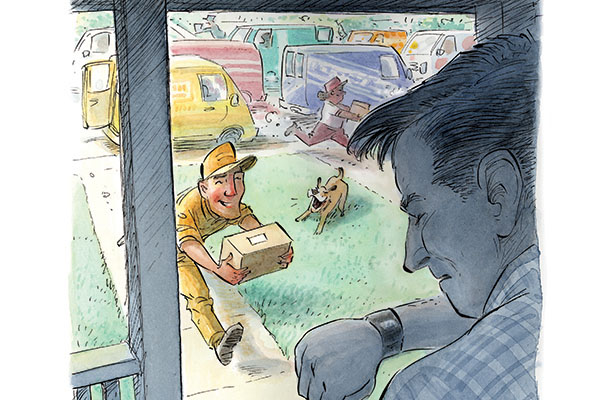2019 Parcel Express Roundtable: E-commerce and Last-Mile continue to flip the script
Coming off of a year that saw notable gains in volumes and pricing, the parcel market continues to grow at a fast clip. Our panel of parcel experts examines key market drivers and discusses how to navigate the fastest moving segment of logistics.
When the economy is performing at a high level, as it was for most of 2018, it’s especially important for the dynamic parcel express market to be on top of its game. Why? Well, more consumers than ever are leaning toward e-commerce and are shopping online for goods ranging everywhere from toothpaste to large appliances—and they want it delivered as quickly as possible.
All of this dynamic activity has introduced the need for increased services, not only from the parcel duopoly of FedEx and UPS, but also from national and regional last-mile logistics providers looking to establish themselves, as well as 3PLs that are increasingly upping their parcel offerings on an regular basis.
In our annual effort to get shippers up to speed on this constantly-changing market, we’re joined by:
Jerry Hempstead, president of Hempstead Consulting, a parcel advisory firm.
David Ross, transportation and logistics director at investment firm Stifel

Rob Martinez, president and CEO at Shipware, an audit and parcel consulting services company.
Logistics Management (LM): How would you describe the current state of today’s parcel marketplace?
Jerry Hempstead: The parcel shipping industry, both domestic and international, had a robust 2018. National and regional volumes were up with all the carriers, and they finished up last year with extraordinary service levels due to the investment in their networks during the prior two years. Shippers will not be looking to change carriers due to service issues in the coming year. In the meantime, more enhancements to service are in the pipeline, at least for UPS and FedEx, while profits are up for all the carriers—even the United States Postal Service (USPS) is faring better financially in the parcel space.
Rob Martinez: In a word: dynamic. The big story is the growth of e-commerce and the ongoing Amazon effect. The ‘want it now’ delivery expectations of online consumers has required both carriers and retailers alike to modify shipping processes to accommodate same day and other expedited shipping methods.
At the same time, shipping costs continue to escalate, as the parcel carriers remain focused on revenue enhancement and client retention strategies. In fact, UPS and FedEx have moved away from only raising rates at the start of the year in favor of year-round increases. Small changes to the service guide that can seem innocuous—often quietly implemented throughout the year—can have a major impact on cost.
David Ross: To build on Jerry and Rob’s comments, it’s certainly fast-paced, with increased demands on service from e-commerce along with increased demands on pricing from the large carriers to provide this higher level of service. Many small entrants have tried to carve out a niche, but most have struggled because it’s hard to do without density.
LM: Describe the current rate and pricing environment for parcel shippers.
Martinez: The bottom line is that parcel costs have never been higher. Shippers are wise to study the details of recent rate changes, as they may have more of an impact on your budget than one might perceive at first glance. Apart from the 4.9% average increases to 2019 published rates, many surcharges increased in excess of the 4.9% average, especially those surcharges related to larger packages.
As an example, factoring in mid-year increases taken by each carrier in 2018, the additional handling surcharge for packages weighing more than 70 pounds increased by 92% for UPS and 67% for FedEx. Moreover, fuel surcharge tables were changed several times over the past ten months resulting in higher costs for shippers. Both FedEx and UPS now have four distinct fuel tables—one each for domestic ground, domestic express, U.S. export and U.S. import.
Hempstead: Because there’s limited choice for shippers in the parcel space, all the carriers have been emboldened in their changes in prices, fees, rules and regulations. It appears to those observing the industry that as one carrier adds, modifies or increases a price or fee, so does the other. This is all completely legal, as long as the carriers are not colluding in these changes.
Then the regional carriers will follow similar increases shortly thereafter. The net sum for shippers is that they are being faced with having to budget for all or some of these increases, unless the shipper has negotiated an extraordinary carrier contract that calls for price reductions as the shipper’s volume increases. The notable exception to this is Amazon that has continued to develop its own delivery network so that is can mitigate some of the impact of the outside carrier’s price increases. Obviously not all shippers are in a position to deliver their own packages.
LM: What are the biggest changes for shippers as they relate to dimensional pricing/DIM divisors switching to 139?
Hempstead: The biggest change for shippers was when the exemption of the first three cubic feet for ground shipments was removed. This was a huge hit to a great number of transactions in the network and extremely financially painful to a great number of shippers. Thereafter we have seen the dimensional divisor (LxWxH/x) reduced from 194 to 166, and then to 139. Each time the carriers reduce the divisor, the transection becomes more likely to yield a higher dimensional weight than being billed for the actual weight.
The carriers have become addicted to these revenue increases. None of the industry observers would be surprised to see the divisor reduced in the near future to 120. The challenge to shippers is to become more efficient in creating on the fly or calculating in advance the optimum size to safely transport the item to be shipped.
Martinez: It’s no question that dimensional pricing has adversely affected shipping costs. While shippers have primarily addressed dimension-based pricing with contract negotiation strategies, shippers are also more focused on optimizing packaging to offset a portion of the dimensional pricing impact.
I’ll offer a word of caution: Shippers that leverage the USPS to avoid higher dimensional pricing costs from FedEx and UPS need to know that in June 2019, the shipper-friendly dimensional divisor of 194 will change to 166—but is still favorable to FedEx and UPS’ divisor of 139.
Ross: It’s all in the response. Those who properly understood what was coming and were able to make changes avoided much of the increase. Others had to adjust their pricing to customers because their costs were never going to be that low again. Packaging and product size continue to be important considerations when looking at ways to save on supply chain costs.
LM: How are market conditions affecting service, and what role is the current state of the U.S. economy playing?
Martinez: The growth in e-commerce has required the package delivery companies to expand and automate hub and sort operations and create modifiable, more adaptive global networks. As an example, the growth in online orders of larger and heavier packages has forced FedEx and UPS—whose operations historically have been centered on small packages—to invent new, cost-effective ways of handling non-conveyable freight. With residential deliveries now approaching the majority of all shipments, FedEx and UPS have also been focused on creating delivery densities to make home delivery more cost effective.
Hempstead: Last year was a banner year for volume and service. Usually the two factors are at odds with each other, as increasing volumes normally put pressure on service levels and drag down the performance numbers. Last year was strikingly different. First, Amazon has taken greater control of its transactions by purchasing 20,000 Mercedes delivery vans and manning them with driver owners, and second, because of the changes in the tax laws, FedEx and UPS have taken the opportunity to invest in their networks, which adds to capacity and more efficient throughput.
Additionally, both UPS and FedEx increased staff to record levels to effectively handle the holiday surge in traffic. They have done a far better job this year in the timing of the additions and the reductions in head count as it relates to the anticipated volumes hitting the system. Because the economy is strong and unemployment is so low, I suspect that’s positively correlated to the incredible increase in package counts we saw this season.
LM: How are the more established carriers adjusting to the ongoing influx of new, last-mile competitors?
Martinez: We’re still in the very early stages of this development, so it remains to be seen if these new entrants will make the national carriers stand up and take notice. Rather, the established carriers continue to focus on improving efficiency, protecting margin and reinforcing retention strategies like revenue-based discount programs to disincentive shippers from diverting traffic to alternative carriers.
Ross: At this stage, the upstart last-mile parcel carriers are not having much of an impact; however, last-mile big and bulky delivery is a new niche that’s outside of the traditional FedEx and UPS wheelhouse.
Hempstead: My observation is that the traditional service providers have already added to their menu of services some low-cost, B2C hybrid offerings that utilize the USPS or others to not only compete with, but at times partner with the new last-mile operators. Experimentation is going on with firms like Deliv and Postmates and firms like Spee-Dee and LSO are rebranding and reinventing themselves.
OnTrac and Lasership continue to grow and thrive in the expanding last-mile world. To date, there has been no concerted effort by the “big guys” to thwart off directly competing with the last-mile providers. However, should the economy slow down, all bets may be off the table because network capacity has to be fed.
LM: What advice do you have for parcel shippers in 2019?
Ross: Know your freight. That means know what you’re shipping, when you’re shipping it, how you’re shipping it, and how much you’re shipping. This will allow for better planning for the shipper and the carrier, ultimately resulting in better pricing.
Hempstead: Shippers need to take a step back and cut through the marketing hype.
First, ‘free shipping’ isn’t free. Just look at the record operating profits raked in by FedEx and UPS over the past four quarters. Second, not every package needs to be there in two days. I recall a market research study years ago that found that half the shipments that were sent priority had no negative consequence if they were not delivered by 10:30 a.m. the next business day.
Third, the devil is in the details. In most cases the carriers know more about your business than you do. Shippers need a method and means to audit their shipment data and also archive it. I have seen several cases recently where a carrier has overcharged a customer, per their contract, for long periods of time, but the carriers have a time bar on shippers filing overcharges against them. Finally, contract negotiations have become rocket science. There are so many moving parts with service levels, tiered discounts, accessorial fees and rules—and shippers have to remember that all of them are negotiable.
Martinez: With parcel pricing at all-time highs, more than ever shippers absolutely need to dive into shipping analytics to identify opportunities for cost reduction, whether by changing packaging, modally optimizing and employing least-cost routing at the package level, or negotiating improved contract discounts and terms. At current trends, free shipping may not be sustainable in the near future. Our research finds that nine out of 10 high-volume parcel shippers are overpaying by as much as 30%.

Article Topics
Parcel Express News & Resources
2024 Parcel Express Roundtable: Lower volumes, pricing shifts, and network changes define the market LM Podcast Series: Assessing the freight transportation and logistics markets with Tom Nightingale, AFS Logistics TD Cowen/AFS Freight presents mixed readings for parcel, LTL, and truckload revenues and rates Solving the last-mile delivery issue in New York City Parcel experts examine the UPS-United States Postal Service air cargo relationship amid parcel landscape UPS is set to take over USPS air cargo contract from FedEx FedEx fiscal third quarter earnings see gains amid ongoing volume declines More Parcel ExpressLatest in Logistics
Preliminary April North American Class 8 net orders are mixed Senators take a close look at Amazon with Warehouse Worker Protection Act Despite American political environment, global geopolitical risks could be easing Maryland DOT: $1.9 billion and up to four years to rebuild bridge sunk near Baltimore port April Services PMI contracts after 15 months of growth, reports ISM 2023 industrial big-box leasing activity heads down but remains on a steady path, notes CBRE report Comau’s Advanced Solutions Drive The Benefits Of Automation For Diversified Industries More LogisticsAbout the Author
Subscribe to Logistics Management Magazine

Find out what the world's most innovative companies are doing to improve productivity in their plants and distribution centers.
Start your FREE subscription today.
May 2024 Logistics Management

Latest Resources


















